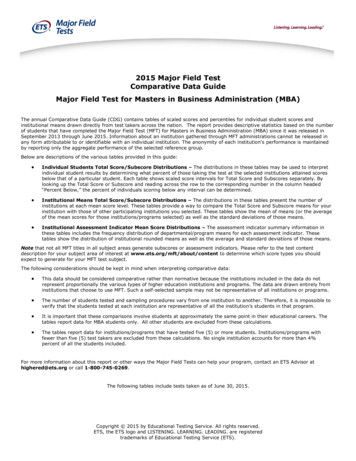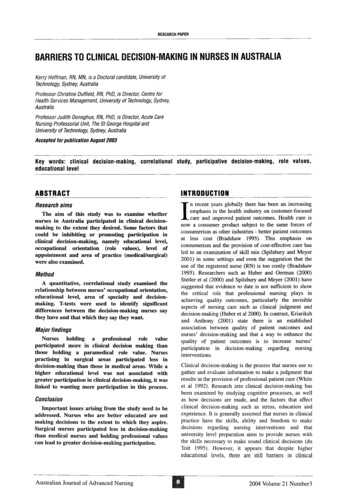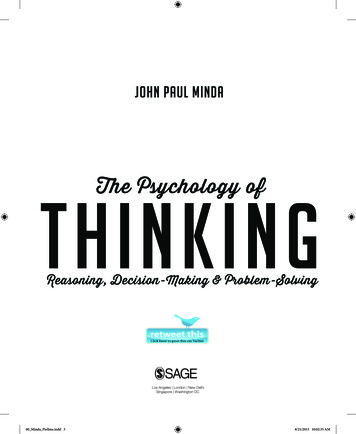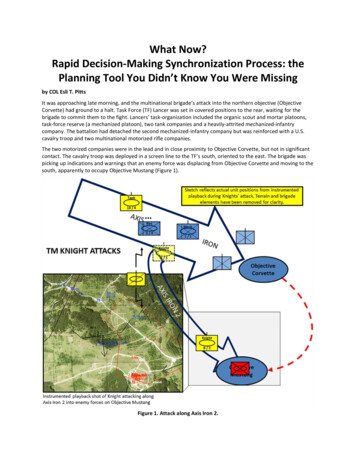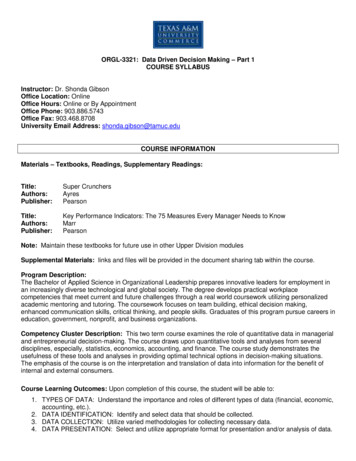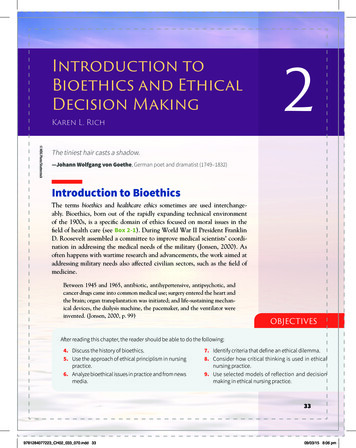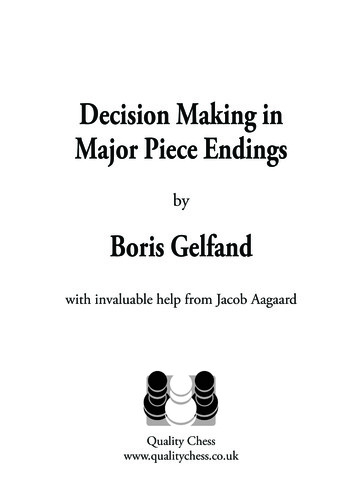
Transcription
Decision Making inMajor Piece EndingsbyBoris Gelfandwith invaluable help from Jacob AagaardQuality Chesswww.qualitychess.co.uk
ContentsKey to symbols used & BibliographyPublisher’s ForewordIntroduction1234567891011121314The Importance of AnalysisDo Not HurryThree Surprisingly Complicated Rook EndingsTwo Defensive Methods in Rook EndingsFrom the Simple to the ComplexDiving to the Bottom of the SeaMamedyarovGrischukQueen Endings with a g- or h-pawnMultiple QueensFull CircleConversion in the 4th PhaseThe Fruits of Hard Work12 Rook ExercisesName IndexGame 17
Publisher’s ForewordThis is the fourth book in the Decision Making in Chess series. It was written over the last coupleof years. A lot of work has gone into this book and the accompanying volume Technical DecisionMaking in Chess, which deals with a wider range of technical topics, whereas this book focuses onpositions without minor pieces.It has been four years since the publication of Dynamic Decision Making in Chess and certainlythere will be one person out there wondering what happened to us and why the third volumewas taking so long to complete. I hope that the content alone of these two books will answer thatquestion.Shipov, Rodshtein, Igor Burshtein, Gelfand andHuzman at the 2009 World Cup in Khanty-Mansiysk
6Boris Gelfand – Decision Making in Major Piece EndingsAs with the previous volumes, we have allowed the material to dictate the format, rather thantrying to force it into a preconceived notion of what the book should look like. The other booksin this series were unique, but will appear similar to each other when compared with this twinpublication.The number of hours that have gone into analysing the games in these two companion volumeshas exceeded even our expectations; and we feel privileged that this is our job. I have neverdone anything as thoroughly and dedicatedly in my life as I have analysed the positions in thisbook. I am exhausted and so must Boris be too. We took turns in pushing each other towardsperfectionism – and beyond.I have written a lot of books and now also close to a handful together with Boris. Taste is apersonal thing and different people need to read different things at different times. So, I shallmoderate my language and simply call this book my favourite.As always, there are a few people to thank on behalf of Boris and myself. The photographers;especially Amruta Mokal, Maria Emalianova, Vladimir Barsky, Vladimir Jagr, Mark Rabkin,Anastasiya Karlovich and others, who so generously shared their work with us.Alexander Huzman is the third co-author to some extent, having shared his findings in manypositions. (However, he cannot be held responsible for a single word on these pages.) You willfind other players’ ideas mentioned throughout the book. There are also suggestions from studentsand friends who are not mentioned, which is an omission by our faulty memories alone. We areindebted to their contribution, even if we are too disorganized and too aged to give credit to all.Jacob AagaardGlasgow, August 2020Yurmala 1985 – I became the USSR U18 Champion!
IntroductionThis is the fourth volume of this series, published at the same time as the third volume, TechnicalDecision Making in Chess. As with the other volumes in this series, this book is not a manual or atheoretical work. There are plenty of those around, by Dvoretsky, Nunn, Averbakh, De la Villa,Mueller and others. I strongly recommend that the readers consult these volumes and choosetheir own selection of positions and ideas to memorize. Relying on a single source will be riskyand although I would recommend all of the books by these authors, none of them eclipses all ofthe others.Rather this book is about decision making at the board and learning from your games – andthose of others. In this book I will discuss topics that have arisen in some of the most interestinggames without minor pieces during my career. We will encounter rook endings, queen endingsand games in what Romanovsky called the fourth phase, which is essentially late middlegames/early endings where only major pieces remain.Some of the lessons will have a certain generality to them and at times I shall refer to generalitiesmost of us have encountered before. I hope the reader shall never mistake my indulging inabstract observations for dogmatism. Chess is a wonderfully complex game and there are manyways to play it. I will explain my way of making decisions and how I approach chess generally.Kirovabad (Ganja), 1984 USSR Junior Championship
8Boris Gelfand – Decision Making in Major Piece EndingsThe importance of deep analysisOne of the most important points to thisbook is its reliance on deep analysis. I haveanalysed a lot of these games with studentsin many countries. These can be promisingkids, or some of the best grandmasters in theworld. Sometimes both at the same time. Theconclusions we have been able to make in thisbook are enhanced by these analyses.I shall talk more about this in the firstchapter of the book, but first let me showyou an interesting example I came across justbefore submitting the book. I suggested toJacob that we should analyse it. Again, I hadthe feeling of entering a parallel universe ofgreater complexity than our own.Evgeny Tomashevsky – Peter SvidlerInternet 2020 Ç Æ Å Ä Ã Â Á À ÈÉÊËÌÍÎÏ This was a blitz game played in the finalof the charity tournament Play for Russia. Inblitz the players cannot play on basic instinctonly. Although the quality of the play in blitzis inherently restricted, the position is not anyless interesting.35. d3We tried to find a way for Black to hold, butit appears none exists.35. e7Black could also have tried active pawn moves.35.g5 36.hxg5 hxg5 37. f337.g4? would create a hook in the whitepawn structure and make it possible forBlack to create counterplay. After 37. e738. f3 b2! 39. e3 f5! and . f6, Blackwill make the draw.37.f5 38. e3 Ç Æ Å Ä Ã Â Á À ÈÉÊËÌÍÎÏ 38. e738. f7 Black can also try to activate theking via the flank, but it does not workout. 39. d4! (39.f4? is premature. After39.gxf4† 40.gxf4 g6 41. d4 h5 Blackis in time to create counterplay and make thedraw.) 39. g6 (39. b2 40.f4 and Whitewins) 40. c4 h5 41.b4 b2 (41. g442. b3 and b2, winning) 42.f3 Whitewins.39.f4!?39. d4! leads to an easier win, but theanalysis of the text move is more interesting.Compared to the note above, the black kingis worse on e7 than on f7.39. f639.gxf4† 40.gxf4 e6 41. d2! is verysimilar.39.g4 40. d2 also does not look like animprovement for Black.40. d2!This is a key point. The king should not goto d4. White needs this square for the rook.
Introduction40.gxf4 41.gxf4 g6 42. c2 e1 Ç Æ Å Ä Ã Â Á À ÈÉÊËÌÍÎÏ 43. c3!The only winning move. The marginsreally are narrow here. White is trying toadvance the b-pawn, while delaying Black’scounterplay on the kingside as much aspossible.43. d4? e8! 44.b4 b8! and Black is in timeto defend from the front, delaying White’sprogress enough to win the necessary time tobring the black king into the game. 45. b3 h5 46. c4 c8†! White cannot be allowedto push the pawn forward. 47. d5 b848. c6 c8† 49. d7 b8 50. c7 FinallyWhite manages to repulse the black rook,but now the white king is far, far away fromthe action on the other side of the board. Ç Æ Å Ä Ã Â Á À ÈÉÊËÌÍÎÏ Black draws with: 50. e8! 51.b5 e452. xe4 fxe4 53.b6 e3 54.b7 e2 55.b8 e1 56. b5† g6 There are no winningchances whatsoever in this endgame.943. c1†43. e4 is not a problem now. White has44. d4, which is a tempo up on the variationright above. 44. e8 45.b4 b8 46. d5!and Black does not have time for . h5.There is no chance for 43. h5 yet. Whitehas 44. g3, winning.44. d4 b1 45. c4 c1† Ç Æ Å Ä Ã Â Á À ÈÉÊËÌÍÎÏ 46. d5White wins easily. Black has failed to createcounterplay.46. b1 47. g3†An annoying check.47. f647. h5 48. g5† h4 loses to 49. c4.48. c3 d1† 49. c5White will win slowly. Compared to thevariation after 43. d4?, Black cannot get theking round to h5.36. f3 Ç Æ Å Ä Ã Â Á À ÈÉÊËÌÍÎÏ
10Boris Gelfand – Decision Making in Major Piece Endings36. f6We also analysed the following variation:36. b2 37. e3 e637.g5 38.hxg5 hxg5 39.f3 f5 40. d4 g241.f4 gxf4 42.gxf4 d6 43.b4 e2 44. c4† c6 45.b5† c7 46. c5 c2† 47. d5 e248. d4 b6 49. c4 xb5 50. c5† and51. d6, winning.38.f4! Ç Æ Å Ä Ã Â Á À ÈÉÊËÌÍÎÏ A strong and instructive move. The rookcan defend the g3-pawn, while the f- andh-pawns are poised for exchanges.38. g2Black seems to have to play to get his king tothe queenside, as it is very difficult to createa passed pawn on the kingside against thiswhite pawn formation.38. f5 39. d4 g4 40. c3 and there isno counterplay on the kingside.39. d4 d6 40. e4† e640. c6 41. f5 g1 42.h5! g2 43.g4 Ç Æ Å Ä Ã Â Á À ÈÉÊËÌÍÎÏ White is threatening to invade with d8-g8,as well as g4-g5, forcing Black to exchange ong5. After fxg5 the f7-pawn will be a target andWhite can seriously consider h5-h6. In somepositions, White can also take with the kingon g5 with the idea of exchanging anotherpawn with h5-h6, when the weak f7-pawn isa great liability for Black. 43.g6† Active playalso does not work. 44.hxg6 fxg6† 45. xg6 xg4† 46. f5 h4 47. e5 White wins. Theh-pawn does not offer real counterplay.41.f5† e7 42.b4 b2 43. d4 g2 44. d5 xg3 45.b5 d7 Ç Æ Å Ä Ã Â Á À ÈÉÊËÌÍÎÏ 46. a4 d3† 47. c5 c3† 48. b6White wins.37. f4 g5† 38.hxg5† hxg5† 39. e4 b240.f3 e6 Ç Æ Å Ä Ã Â Á À ÈÉÊËÌÍÎÏ
Introduction41.g4White is simply winning. Black cannotcreate counterplay; and with weaknesses onthe kingside, it is not possible for him to holdwith passive defence.41.f6 42. e3 b1White would also have won easily after42. d2 43. d3 cutting off the black king.For example, 43. e2† 44. d4 d6 45.b4 e1 46.b5 c1 47. e4† e6 48. b3 with asimple win.43. d4† d6 44. c4 c1† 45. c3 b146.b4 e5 47. c5 f5 48.gxf5 xf5 49.b5 e6 50. c61–0Understanding this endgame was enlighteningto us, and led us to make changes to Chapter 3.When to play by handIn chess we rely a lot on our intuition. We haveto make a lot of decisions in a limited amountof time when we play. However, there are somemoments when we need to go deep – perhaps tocalculate a difficult accurate line, or simply finda way to pose the opponent problems beforehe equalizes completely. Understanding whento make a move “by hand” and when to “godeep” is one of the most important aptitudes todevelop. See my discussion of the topic in thegame against Edouard on page 257.Some general principles put on the lineThe principle of “don’t hurry” became famousfrom the book Endgame Strategy by MikhailShereshevsky. It refers to the technique ofclassical players such as Rubinstein andCapablanca, where they would build up theirposition slowly, when the opponent would beunable to do anything active. You will see thisat play many times throughout this book.11There are other truisms, such as “passedpawns must be pushed”, which simply meansthat in most situations, passed pawns are morevaluable when they are further up the board.This is true, except in the cases where there is aconcrete reason for this not being the case. Youwill find both in this book. And then of coursethere is the question: when you have twopassed pawns, which one should you push?You will find that these generalities are justsuggestions, and that strong players may payattention to some of them, but they will alwaysmake decisions based on something concrete.Take the idea that when you have a materialadvantage, you should seek to exchange pieces,while the opponent would want to exchangepawns. In my game against Hernandez onpage 49, you will see that not all exchanges arealike. The exchange of rooks would seriouslyendanger the win, while the exchange ofbishops eventually decided the game. Chessis too complex to be wrapped into simpleslogans; it is also too complex to be played wellwithout some general idea of which directionyou should be headed.EnginesWhile working on this book, we used enginesand tablebases. It is my firm conviction that weshould think for ourselves as much as possible.In many areas the computers are strongerthan humans, but in other areas humanunderstanding is still ahead.I always encourage young players whofollow games online to do so with the engineturned off. Your brain is not active when youare looking at the engine variations; you willnot be able to develop a way to solve problems,which you will certainly need when you are theone sitting at the board.Also, your evaluation of positions will lackan important element if you blindly follow the
12Boris Gelfand – Decision Making in Major Piece Endingscomputer evaluations. In this series I will oftensay things such as “everyone would chooseWhite”, which refers to situations where theengines cannot tell the two sides apart, butthe practicalities favour one player immensely.This is very important when you are preparingopenings, but also matters a lot when you areanalysing endgames, and trying to understandhow chess is best played; which will eventuallyhelp mould your intuition.I encountered a really striking piece ofmisinformation while working on this series,which can be foun
Major Piece Endings by Boris Gelfand with invaluable help from Jacob Aagaard Quality Chess www.qualitychess.co.uk. Contents Key to symbols used & Bibliography 4 Publisher’s Foreword 5 Introduction 7 1 The Importance of Analysis 19 2 Do Not Hurry 47 3 Three Surprisingly Complicated Rook Endings 65 4 Two Defensive Methods in Rook Endings 93 5 From the Simple to the Complex 121 6
